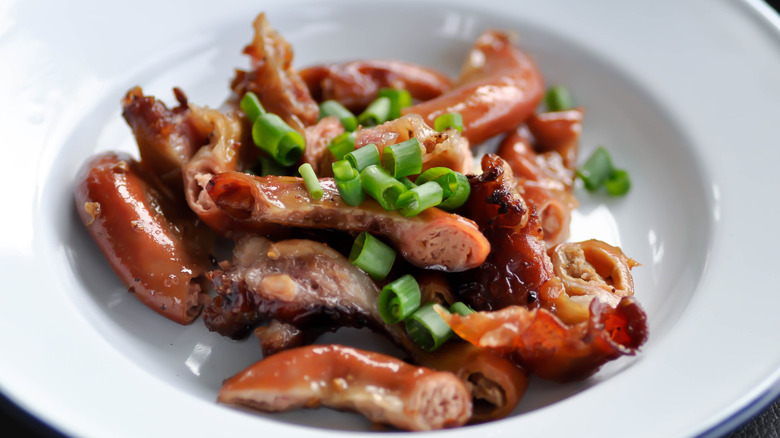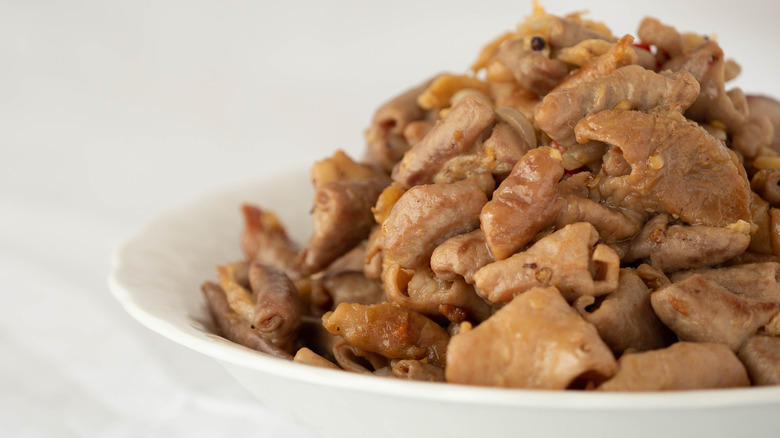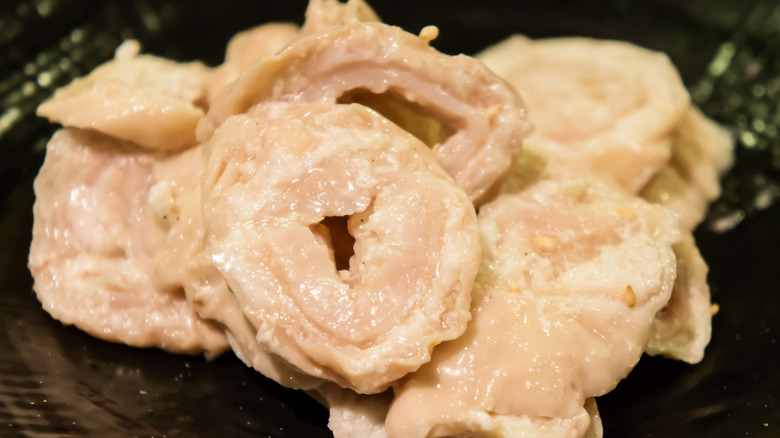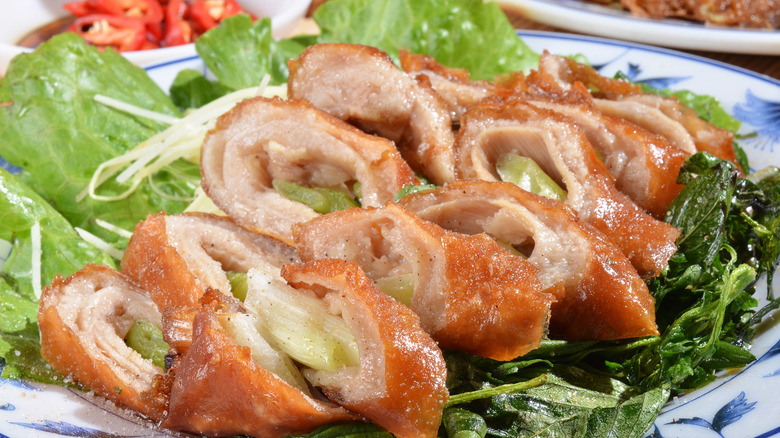Pork Bung Is Basically What It Sounds Like
For many unfamiliar with this cut, you may wonder, "What is pork bung?" Pork bung may be a little less familiar than some other offcuts of meat, and it admittedly doesn't have as great of a rebrand as sweetbreads, which are actually tender pieces of the pancreas or thymus gland. Let's cut to the chase — pork bung is part of the intestines of a pig, specifically the rectum. Sometimes the terms pork bung and pork chitterlings are used interchangeably, but technically, pork bung is from the large intestines, and pork chitterlings are from the small intestines.
Utilizing the whole animal to avoid waste and create inspired dishes has been called nose-to-tail eating. It sounds trendy, but really, it is a throwback to how cooking has always been done. Across the United States and the world, people have long been eating more than just tenderloins and chicken cutlets. Some of these dishes are widely accepted. Think French pâté (chilled whipped livers), Scottish haggis (a savory pudding featuring sheep offal), Spanish morcilla (blood sausage), or Mexican menudo (stomach lining soup). When you buy sausage or pepperoni in a natural casing that means that the filling, which can also include any number of animal bits and pieces, is stuffed into intestines.
Pork bung, when prepared correctly, can be delightful — fatty and creamy on the inside with an outside that is just begging to be crisped up in a deep fryer. It has textural intrigue and a pleasant gaminess that makes you want to have another taste.
How is pork bung prepared?
Pork bung might ring a bell because it was the subject of unconfirmed rumors that some rings of crispy fried salt and pepper calamari were not calamari at all. Interestingly, pork bung is often prepared very similarly — cut into rings and deep-fried. Just like other organs, like gizzards and honeycomb tripe, a low and slow cook tenderizes the pork bung and is a necessary pre-treatment before frying.
Crispy rings of pork bung are often served with punchy soy, vinegar, or hoisin-based sauce or pickled vegetables to balance out that fatty and creamy offal taste. The Filipino version, called crispy bagbagis, is served with a spicy coconut vinegar sauce called sinamak that features garlic, ginger, bird's eye chilies, and black peppercorns. Pork bung can be slow braised or pressure cooked with aromatics and then eaten in soups and stews, or crisped up in a pan afterward for stir-fries or tacos.
Where can you purchase pork bung?
If your interest is piqued, your best chance of getting your hands on raw pork bung is by taking a trip to an Asian market. If they don't have it fresh, check the frozen section where you can also find some other preparations like pork bung filled with sweet rice. Mexican and Latin American stores will more than likely carry tripas, which refers to the small intestines.
Some supermarkets, especially in the southern United States may carry chitterlings, also called chitlins, but those are also part of the small intestines. They are handled similarly, so the small intestine is definitely worth trying if you can't find pork bung, but the large intestine is fattier and richer, which does give it a taste and texture that's totally unique. You can also find pork bung online through specialty meat retailers or Asian purveyors, or go to your local small-scale butcher shop and make a special request. They typically receive and process whole animals, so you'll have your pick of pork bung and any other cuts of offal your heart desires.
How do you clean pork bung?
Like with any organ, pork bung does take a certain technique and attention to cleanliness to prepare safely because there is a risk of illness caused by Yersinia enterocolitica, notes the Center for Disease Control. After all, this organ does process waste, but once you clean it and cook it, pork bung is perfectly safe to eat.
Even if you buy pre-cleaned pork bung, as most of the pork bung from major retailers is, it is still crucial to clean it thoroughly and to disinfect all surfaces that came in contact with the intestines like the sink, utensils, colander, countertops, cutting boards, and your hands. Of course, this is vital when handling and preparing any raw meat.
For the utmost attention to safety, start by boiling the pork bung for around five minutes before cleaning the meat with water. Then, scrub with salt and rinse both the smooth inside and the fattier outside of the pork bung with clean water a few times. Soak the intestines in a water and vinegar solution before boiling for ten minutes to ensure that any harmful bacteria have been killed. Drain the intestines and bring them back to a boil in a new pot with fresh water and any aromatics you'd like — scallions, ginger, onion, carrot, celery, or black pepper to name a few options.
If this process sounds too intimidating, your best bet is to find a traditional Malaysian, Chinese, Cambodian, or East Asian restaurant, or someone's grandparent who has a tried and true recipe, so you can experience pork bung at its best.




